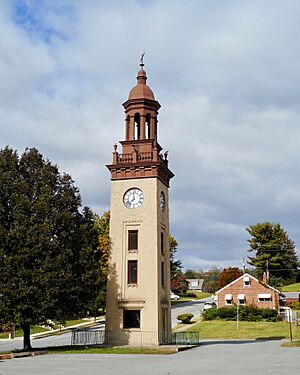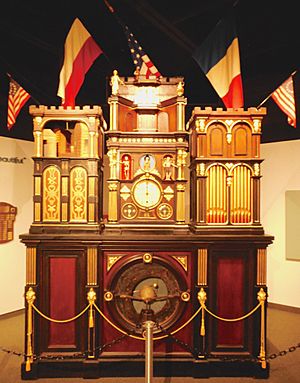National Watch and Clock Museum facts for kids
The National Watch and Clock Museum (NWCM) is a special place in Columbia, Pennsylvania. It is one of the few museums in the United States that focuses only on horology. Horology is the study of time. It also covers the science and art of making things that tell time, like clocks and watches.
The National Watch and Clock Museum is run by the National Association of Watch and Clock Collectors (NAWCC). This group is a non-profit organization. It has about 10,000 members. Their main goal is to teach people about timekeeping.
A Look Back: The Museum's Story
The National Watch and Clock Museum opened in 1977. It was started by the NAWCC. Since then, the museum has gathered a huge collection of items about time. These include many clocks and watches. They also have tools, machines, and other related items. The museum has become very important in the world of timekeeping.
Many famous clocks and watches are shown in big museums. Places like the British Museum in London or the Metropolitan Museum in New York display them as art. Other large museums, like the Smithsonian Institution, have small sections for timekeeping. But there are only a few museums like the NWCM. These museums are mainly about the history of timekeeping. Most of them focus on a local area.
In the 1990s, the "Time Museum" in Illinois closed. Since then, the NWCM is often called the most complete museum about time in the country. The American Clock & Watch Museum in Bristol, Connecticut is similar. However, that museum mostly shows timekeepers made in America.
The museum is located near the Susquehanna River. This area is part of Lancaster County's Pennsylvania Dutch Country. The museum welcomes everyone, including families and young people. It also serves people who love timekeeping, like NAWCC members. They enjoy the special collections and temporary exhibits.
What You Can See: Museum Exhibits
The museum shows the full history of timekeepers. You can see the very first devices that didn't use machines. These include sundials, hourglasses, and fireclocks. You can also see modern items like the atomic clock and mass-produced wristwatches. The museum has over 12,000 clocks and watches. About 3,000 of these are on display.
There is a "Learning Center" at the museum. It teaches you about the basic parts of mechanical timekeepers. For example, you can learn about the pendulum. There is also a large exhibit on different types of clock escapement. The museum has a great collection of American-made tall case clocks. These are often called "grandfather clocks." You can also see a full exhibit on American watches. There is a small but excellent area showing machines used to make watches.
Other cool things to see include machines from the American Waltham Watch Company. This company was the first to mass-produce watches. They made watches using parts that could be swapped easily. You can also see many American pocket watches, including Railroad watches. A special highlight is the "Engel Clock." This is a very complex clock. Stephen Decatur Engle from Hazleton, Pennsylvania built it.
It took Engel about 20 years to finish this clock. It was shown all over the United States starting around 1877. The Engel clock disappeared in the early 1950s. It was found in a barn in New York State in 1983. The NAWCC bought the clock and fixed it completely in 1989. Now, it is on display at the museum.
The NWCM always has new temporary exhibits. Usually, there are two at a time. One exhibit is for the general public. It covers a timekeeping topic that everyone might find interesting. The other exhibit is more specialized. It is usually for people who collect timepieces.







